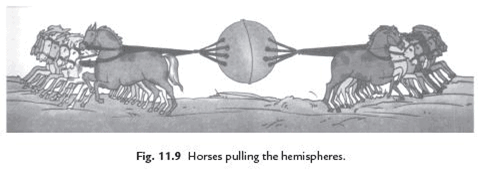Force and Pressure Class 8 Important Questions and Answers
Important questions of Class 8 Science Chapter 11 Force and Pressure is given below. These important questions will help students while preparing for the exam. Practising these important questions will analyse their performance and work on their weak points. Score well in exam of Class 8 Science by going through these important questions. Students of Class 8 can download important questions of Class 8 Science Chapter 11 Force and Pressure PDF by clicking the link provided below.
Important Questions of Class 8 Science Chapter 11 Force and Pressure
Here you can get Class 8 Important Questions Science based on NCERT Text book for Class 8. Science Class 8 Important Questions are very helpful to score high marks in board exams. Here we have covered Important Questions on Force and Pressure for Class 8 Science subject.
Very Short Answer Questions
1. How can we decide whether an object is moving faster than the other?
Answer: By their speed.
2. What is the distance moved by an object in unit time called?
Answer: Speed.
3. How can we change the speed and the direction of a moving body?
Answer: By applying force.
4. What is force?
Answer: A push or a pull on an object is called force.
5. What is the requirement for a force to come into play?
Answer: Interaction between two objects is required for a force to come into play.
6. What is the resultant force when two forces act in same direction?
Answer: Forces applied on an object in the same direction add to one another.
7. What will be the resultant force when two forces act in opposite directions on an object?
Answer: When two forces act in opposite directions on an object then the net force will be the difference between two forces.
8. What happens in a tug of war when two teams pull equally hard?
Answer: When two teams pull equally hard then the rope does not move in any direction.
9. Name the term used to express the strength of a force.
Answer: Magnitude.
10. When does the net force become zero?
Answer: When two forces acting on an object in opposite directions are equal then the net force becomes zero.
11. A ball is at rest. Push it gently. Does the ball begin to move?
Answer: Yes, the ball begins to move.
12. What happens when we push again while the ball is moving?
Answer: When we push a moving ball, then its speed increases.
13. Place your palm in front of a moving ball. Does your palm apply any force on the ball?
Answer: Yes, our palm applies a force on the ball.
14. What happens to the speed of the ball when you place your palm in front of the moving ball?
Answer: The speed of the ball is decreased.
15. What are the two states of motion?
Answer: There are two states of motion: (i) The state of rest (ii) The state of motion.
16. Does the application of a force would always result in the change in the state of motion of an object?
Answer: No, it does not always change the state of motion of an object.
17. What is muscular force?
Answer: The force resulting due to the action of muscles is known as muscular force.
18. Give two examples of muscular force.
Answer: Bending of our body and kicking the ball.
19. Does the force can change the speed of a moving object?
Answer: Yes.
20. What effect does a force put on the shape of an object?
Answer: The force may cause change in shape of the object
21. Is muscular force a type of contact force?
Answer: Yes, muscular force is a type of contact force.
22. What is force of friction?
Answer: The force which acts on all moving objects in opposite direction to the motion of the body is called force of friction.
23. What kind of force is friction?
Answer: Force of friction is also a type of contact force.
24. Why is force of friction called contact force?
Answer: Since the force of friction arises due to contact between surfaces of moving body and other surfaces, so it is called a contact force.
25. Give two examples of contact forces.
Answer: (i) Muscular force (ii) Force of friction
26. What are non-contact forces?
Answer: The forces acting from a distance without making contact are called non-contact forces.
27. Give an example of a non-contact force.
Answer: Magnetic force.
28. What is magnetic force?
Answer: The force exerted by a magnet on any magnetic object is called magnetic force.
29. What are the interaction of poles of two magnets?
Answer: (i) Like poles repel each other. (ii) Unlike poles attract each other.
30. What do you mean by electrostatic force?
Answer: The force exerted by a charged body on another charged or non-charged body is called electrostatic force.
31. What kind of force is an electrostatic force?
Answer: It is non-contact force.
32. What is gravitational force?
Answer: The force by which earth or any other object attracts objects towards itself is called the gravitational force.
33. Is the gravity a property of earth only?
Answer: No, gravity is not a property of earth only.
34. Is the gravitational force a contact or non-contact force?
Answer: The gravitational force is non-contact force.
35. Name the force due to which every object falls on the earth.
Answer: Due to gravitational force.
36. What do you mean by pressure?
Answer: The force acting on a unit area of a surface is called pressure.
Pressure = Force/Area
37. How can we increase the pressure by exerting same force?
Answer: To increase pressure we should exert the same force on a smaller area.
38. Do liquids and gases also exert pressure?
Answer: Yes, liquids and gases also exert pressure.
39. What is the site of the pressure exerted by a liquid on the container?
Answer: A liquid exerts pressure on the walls of the container.
40. Do gases also exert pressure on the walls of containers?
Answer: Yes, gases also exert pressure on the walls of the containers.
41. What is atmosphere?
Answer: The envelop of air around us is called atmosphere.
42. What is atmospheric pressure?
Answer: The pressure exerted by the air is known as atmospheric pressure.
43. Can you separate two hemispheres, if all the air is suck out from them?
Answer: There is no air inside the two hemispheres, so only outer surface is in contact of atmospheric pressure. This is because we cannot separate them.
Short Answer Type Questions
1: What is force? What is its unit?
Answer: A push or a pull on an object is called a force. It arises due to the interaction between two objects. Force has magnitude as well as direction. It may change in the state of motion of an object or it may bring about a change in the shape of an object. The unit of force is Newton.
2: What is change in state of motion? What brings change in state of motion?
Answer: A change in either the speed of an object, or its direction of motion, or both, is described as a change in its state of motion. Force may bring the change in the state of motion of an object.
3: What is the difference between contact forces and non-contact forces?
Answer: Forces which act only when there is physical contact between two interacting objects are known as Contact forces. Example: Muscular force. Whereas Forces which can act without physical contact between objects i.e. those that can act from a distance, are called non-contact forces or field forces. Example: Magnetic force.
4: Give two example each of the situation in which you apply force to change state of motion of an object and to change shape of an object?
Answer: A goal keeper applies force for saving a goal. By his action the goal keeper tries to apply a force on the moving ball. This leads to change in state of motion of ball.
Force is applied to the shape of a ball of dough when it is rolled to make a chapatti.
5: Why is it difficult to hold a school bag having a strap made of a thin and strong string?
Answer: It is difficult to hold a school bag having a strap made of a thin and strong string because it apply the large pressure on the shoulders due to very small contact surface area. The pressure is inversely proportional to the surface area on which the force acts. Therefore, pressure decreases if surface area increases.
6: Why Porters wear turbans when they have to carry heavy loads on their heads?
Answer: Porters wear turbans when they have to carry heavy loads on their heads, to increase the area of contact. This reduces the pressure on the head.
7: Force applied on an object may change its speed. How?
Answer: force applied on an object may change its speed. If the force applied on the object is in the direction of its motion, the speed of the object increases. If the force is applied in the direction opposite to the direction of motion, then it results in a decrease in the speed of the object
8: Why Lorries and trucks carrying heavy loads have 8 tyres instead of four?
Answer: Lorries and trucks carrying heavy loads have 8 tyres instead of four. Also the tyres are broader because this increases the area of contact with the ground, thus reducing the pressure exerted on the ground.
9: Why the sucker sticks to the surface over which it is pressed?
Answer: When we press the sucker, most of the air between its cup and the surface escapes out. The sucker sticks to the surface because pressure of atmosphere acts on it. To pull the sucker off the surface, the applied force should be large enough to overcome the atmospheric pressure.
10: What is pressure? How is pressure related to the surface area on which it acts?
Answer: Force per unit area is called pressure. Pressure is inversely proportional to the surface area on which it acts. Smaller the area, larger the pressure on the surface for the same force.
11: When we stop pedalling the bicycle, it slows down and gradually stops .Why?
Answer: When we stop pedalling the bicycle, it slows down and gradually stops because of force of friction between the surface of tyres of cycle and the ground that brings moving bicycle to rest. The direction of force of friction is always opposite to the direction of motion.
12: What is frictional force? How it arises?
Answer: The force acting against the relative motion of surfaces in contact is called frictional force or friction. Friction is an example of contact force. Force of friction arises due to contact between surfaces.
13: What is magnetic force? What happens when we bring like poles of two magnets closer?
Answer: A magnet can exert force on another magnet without being in contact with it; this force is known as magnetic force. Like poles of two magnets repel each other. Unlike poles of two magnets attract each other.
14: What is gravitational force? Is gravity the property of earth alone?
Answer: Every object exerts a force on every other object. This force is known as gravitational force. Gravity is not a property of the earth alone. Every object in the universe whether large or small exerts gravitational force on every other object.
15: A rocket has been fired upwards to launch a satellite in its orbit. Name the two forces acting on the rocket just after leaving of the launching pad
Answer: The force acting on a rocket is:
- Frictional force due to air
- Force of gravity acting in downward direction.
16: What will be the effect of force while squeezing a piece of lemon between the fingers?
Answer: Agent exerting pressure: Fingers.
Object: Lemon.
Effect of force is observed: Lemon juice is coming out, change in shape of lemon.
17: What will be the effect of force while taking out toothpaste from toothpaste tube?
Answer: Agent exerting pressure: Fingers.
Object: Tooth paste tube
Effect of force is observed: Tooth paste is coming out, change in shape of tooth paste.
18: A blacksmith is hammering a hot piece of copper for making a tool, how does the force due to affect the piece of copper?
Answer: The force due to hammering changes the shape of the hot piece of copper to make tools.
19: What are the effects of the force while making high jump by an athlete?
Answer: Agent exerting pressure: An athlete.
Object: Body
Effect of force: Jumping
20: Differentiate between atmosphere and atmospheric pressure.
Answer: Atmosphere is the envelope of air surrounding our earth but the atmospheric pressure is the pressure exerted by this air.
21: Differentiate between friction and contact force.
Answer: Friction is the force responsible for changing the state of motion of objects but contact force is the forces which act only when there is physical contact between two interacting objects.
22: What is a force? Explain with the help of some examples.
Answer: Force is a pull or push of the objects. The action like, pushing, pulling, picking, hitting, lifting, running and bending are the examples of force. Moving or stopping of a body, changing shape and direction of motion of objects are various actions which show force in play.
23: How do we feel force in our daily life?
Answer: Various big or small actions make us feel the force. We hit or catch many objects in our daily life. We see that a moving ball stops on its own. The ball changes the direction of its motion when it is hit with a bat. We make lassi etc. by churning of curd. These are many actions which help us to feel that a force is exerted.
24: Explain that forces are due to an interaction between objects.
Answer: Imagine, a man is standing behind a stationary car. The car does not move due to his presence.
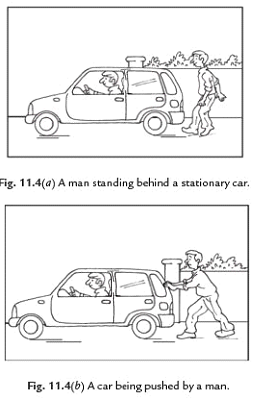
Now allow the man to push the car, it means he applies a force on the car. The car may begin to move in the direction of the applied force. Note that the man has to push the car to make it move. This example shows that at least two objects must interact with each other for a force to come into play.
25: What happens when (i) Two forces are exerted in same direction?
(ii) Two forces are exerted in opposite directions?
Answer: (i) When two forces are exerted in same direction on an object, then the forces are added and action becomes easy.
(ii) When two forces act in the opposite directions on an object, the net force acting on it is the difference between the two forces.
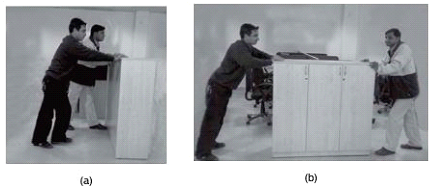
26: What are the two factors on which effect of force depends?
Answer: There are following two factors on which the effect of force depends:
(i) Magnitude: The strength of force is usually expressed by its magnitude.
(ii) Direction of force: We have also to specify the direction of force in which it acts.
If the direction or magnitude of force changes, its effect also changes.
27: What are the effects of force?
Answer: A force changes or try to change the
(i) Speed of a moving body.
(ii) Direction of motion of a body.
(iii) Shape of a body.
28: What are states of motion?
Answer: An object can be in two positions, one is at rest or other in motion ; both are its states of motion. Any change in this position (rest or motion) can be called the change in the state of motion. The state of motion of an object is described by its speed and the direction of motion.
29: How can a force change the states of motion?
Answer: There are two states of an object:
(i) Rest
(ii) Motion
When a force is applied on a body then it can move. In the same way a force can change the direction of a moving object as well as its speed. A force can stop a moving object.
If the force is applied in the direction of motion at an object, then its speed is increased. If the force acts in opposite direction, then the speed of the object is decreased.
30: What is the effect of force on the shape of an object?
Answer: A force can change or try to change the shape of an object. When a force is applied on an object then change in shape takes place. It may be smaller or greater. At last we can say that the application of force on an object may change its shape.
31: Explain contact and non-contact forces.
Answer: Contact forces: The forces which come into play only when two objects come in contact with each other are called contact forces. Muscular force and force of friction are the examples of contact forces.
Non-contact forces: The forces which come into play without any contact of objects with one another are called non-contact forces. Electrostatic and magnetic forces are the examples of non-contact forces.
32: What is muscular force? Why is it called contact force?
Answer: The force resulting due to the action of muscles is known as the muscular force. Muscular force is called contact force because it comes in action only when two bodies come in contact with each other.
33: What do you understand by the force of friction?
Answer: The force which always acts on all the moving objects and whose direction is always opposite to the direction of motion is called force of friction. Since the force of friction arises due to contact between surfaces, it is also called contact force.
34: What is electrostatic force? Why is it called non-contact force?
Answer: The force exerted by a charged body on another charged or uncharged body is called electrostatic force. This force comes into play even when the bodies are not in contact, so it is called non-contact force.
35: Explain force of gravity.
Answer: Objects or the things that fall towards the earth because the earth pulls them. This force is called force of gravity or the force due to gravitation. This is also called just gravity. It is an attractive force. This force acts on all objects.
36: What is pressure? What happens to the pressure when area on which it is applied increases?
Answer: The force acting on a unit area of a surface is called pressure.
Pressure = Force/Area on which it acts.
The pressure is inversely proportional to the area on which force is applied. As the area on which force is applied is increased, the pressure decreases. We can say that pressure increases with decrease in area.
37: We observe that the wheels of buses and trucks are heavier than the wheels of cars or scooters. Why?
Answer: The buses and trucks are heavy and require to exert less pressure. We know that pressure decreases as area of contact increases, so the tyres are broadened so that they exert less pressure on earth and move easily. If they exert more pressure, they will sink in earth. The scooters and cars have less wide wheels because they need more pressure for gripping.
38: What is atmospheric pressure?
Answer: The envelop of air around the earth is known as atmosphere. The atmospheric air extends up to many kilometres above the surface of the earth. The pressure exerted by the air is called atmospheric pressure.
39: If the area of your head is 15 cm × 15 cm, how much air (in weight) would you carry on your head?
Answer: The weight of air column of the height of the atmosphere and area 15 cm × 15 cm is equal to the weight of an object of mass 225 kg (2250 N). We have air inside our body, so we are not crushed under this weight and pressure of air is equal at both the sides.
Long Answer Type Questions
1: Explain contact and non-contact forces. Give two examples for each.
Answer: Contact forces: Forces which act only when there is physical contact between two interacting objects are known as Contact forces.
Example:
Muscular force: This is the force we can exert with our bodies by using our muscles, e.g: push, pull etc.
Frictional force: The force acting against the relative motion of surfaces in contact is called frictional force or friction.
Non-contact forces: Forces which can act without physical contact between objects, i.e. those that can act from a distance, are called non-contact forces or field forces.
Example:
Magnetic force: Magnets exert forces of attraction or repulsion on other magnets
Electrostatic force: The force exerted by a charged body on another charged or uncharged body is known as electrostatic force.
2: (a) How can friction be reduced?
(b) How can it be increased? Give examples.
Answer: We can reduce Friction
1. By using wheels and ball bearings. Use of wheels between surface moving over each other reduces friction. Ball bearings have small balls of steel between steel surfaces. Because of the balls the steel surfaces can easily moves over each other.
2. By making the rubbing surfaces smooth by polishing them.
3. By using a suitable lubricant, like oil (for light machinery) or grease (for heavy machinery). This helps because fluid friction is less than solid friction.
4. Friction due to air (air resistance) or water is reduced by using streamlined shapes in aeroplanes or ships. A streamlined shape is narrow in front and broader at the back. Birds and aquatic animals have streamlined shapes which held them in flying or swimming.
We can increase Friction by the following ways:
1. Sand and gravel is strewn on slippery ground during the rainy season to increase friction. It is then easier to walk on the ground.
2. By making the moving surfaces rough, e.g. tyres have designs and patterns with grooves on the surface to increase resistance with the road. This prevents slipping of the tyres on a wet road.
3. To increase friction, spikes are provided in the soles of shoes used by players and athletes.
3: Do liquid and gases exert pressure on the walls of container in all direction? Give example to justify your statement.
Answer: Liquid and gases exerts pressure on the walls of container. For example, If we take a plastic bottle and drill four holes around near the bottom of bottle at the same height. After filling the water in that bottle, we observe that water comes out of the holes and falls at the same distance. This shows that liquid exerts pressure on the walls of container in all directions.
Similarly, we are not able to inflate a balloon which has holes because air inside balloon exerts pressure in all direction. Hence we can say that gases exert pressure on the walls of container in all directions.
4: Why is it easy to push a nail into a wooden plank by the pointed end?
Answer: It is easy to push a nail into a wooden plank by pointed end because the smaller the area, larger the pressure on a surface for the same force. The area of the pointed end of the nail is much smaller than that of its head. The same force therefore produces a pressure sufficient to push the pointed end of the nail into the wooden plank.
5: Read Table and try to identify the action as push or pull.
Answer: Table Identifying Actions as Push or Pull
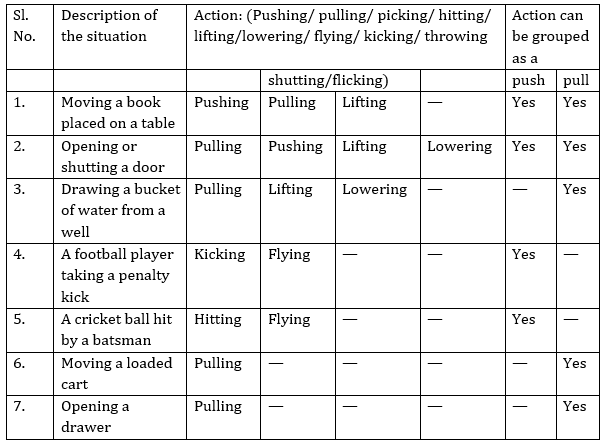
6: Read Table and complete it.
Answer: Table Studying the Effect of Force on Objects
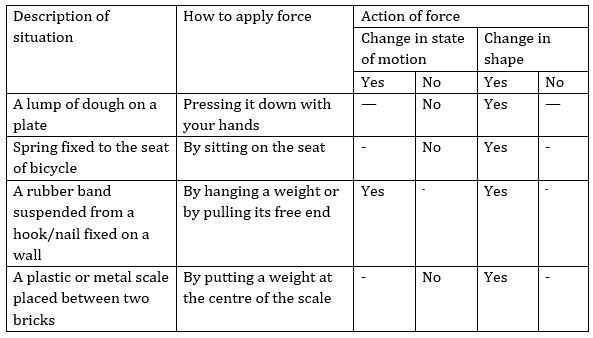
7: What are the various effects of force on different objects?
Answer: The various effects of force are:
(i) A force can make an object move from rest.
(ii) It can change the speed of a moving object.
(iii) It can bring about a change in the shape of an object.
(iv) It can change the direction of motion of an object.
(v) It can cause some or all of these effects.
8: What are contact forces? State different types of contact forces.
Answer: The forces which come into play only when two objects come in contact with each other are called contact forces.
Some contact forces are:
(i) Muscular force: The forces resulting due the action of muscles are known as muscular forces. Muscular force is a contact force because it comes into play when two object, come in contact with each other.
(ii) Force of friction: When a body is moving, then a force equal and opposite to the direction of motion is exerted on that moving body. This force is called force of friction. It is also a contact force because it is exerted when two surfaces come in contact with each other.
9: What are non-contact forces? Explain different types of non-contact forces.
Answer: The forces which can be exerted from a distance, without establishing a contact are called non-contact forces. Some non-contact forces are:
(i) Magnetic force: The force exerted by a magnet on other magnet or some other magnetic substance like iron is called magnetic force. Like poles of a magnet repel each other and unlike poles of a magnet attract each other without contact. So it is called non-contact force.
(ii) Electrostatic force: The force exerted by a charged body on other charged or uncharged body is called electrostatic force. Electrostatic force also acts without making a direct contact with other charged or uncharged body. So it is also a non-contact force.
(iii) Force of gravity: Earth pulls every thing or body towards it. The force of attraction exerted by earth on any object is called force of gravity. This is also a non-contact force as it acts from a distance.
10: What is force? Name different types of forces.
Answer: A push or pull on an object is called force. There are following types of forces:
(i) Muscular force
(ii) Force of friction
(iii) Magnetic force
(iv) Force of gravity
(v) Electrostatic force
11: Prove that the force of friction depends on the nature of the two surfaces in contact.
Answer: Collect the following things: A thick book, nylon cloth, gunny cloth, plastic sheet, jute cloth and sand paper. Place the book on each of the materials and slide it on the floor one by one. If your book slides off the plastic sheet or nylon cloth, use adhesive tape to stick it firmly on the surface of the book.
You will observe that the different materials offer different amounts of resistances to sliding.
This activity shows that force of friction depends on the nature of the surface in contact. In general, smooth surface offers lesser friction than rough surface.
12: Prove that the pressure exerted by water at the bottom of the container depends on the height of its column.
Answer: Take a transparent glass tube or plastic pipe. Also take piece of thin sheet of a good quality rubber. Stretch the rubber sheet tightly over one end of pipe. Hold the pipe at the middle, keeping it in a vertical position. Pour some water in the pipe. Note the height of the water column in the pipe. Pour some more water. Observe, the bulge in rubber sheet and height of water column in the pipe.
Repeat this process a few more times. You observe that as the height of water column increases the bulge in the rubber sheet also increases.
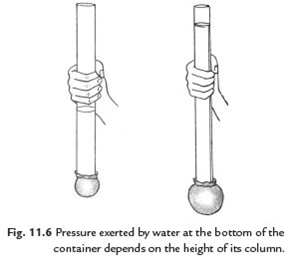
13: Show that a liquid exerts pressure on the walls of the container.
Answer: Take a plastic bottle. Fix a cylindrical glass tube a few cm long near its bottom. You can do so by slightly heating one end of the glass tube and then quickly inserting it near the bottom of the bottle. Make sure that water does not leak from the joint. If there is any leakage seal it with molten wax. Cover the mouth of the glass tube with a thin rubber sheet. Now fill the bottle up to half with water. We observe the bulge in the rubber sheet. Pour some more water in the bottle. We see more bulge in rubber sheet. This activity indicates that water exerts pressure on the walls of the container.
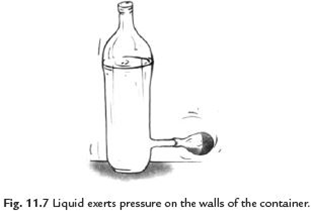
14: Explain that liquids exert equal pressure at the same depth.
Answer: Take an empty plastic bottle. Drill four holes all around near the bottom of the bottle. Make sure that all the holes are at the same height from the bottom. Now fill the bottle with water. We observe that different streams of water coming out of the holes fall at the same distance from the bottle. This observation indicates that liquids exert equal pressure at the same depth.
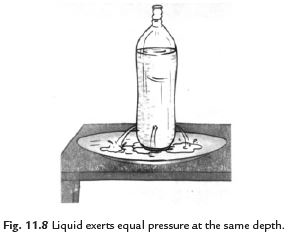
15: What experiment was performed to prove that air has pressure?
Answer: Otto von Guericke, a German Scientist invented a pump in 17th century to extract air out of a vessel. He demonstrated the force of the air pressure. He joined two hollow metallic hemispheres of 51 cm diameter each and pumped air out of them. Then he employed eight horses on each hemisphere to pull them apart. So great is the force of air pressure that the hemispheres could not be pulled apart.
